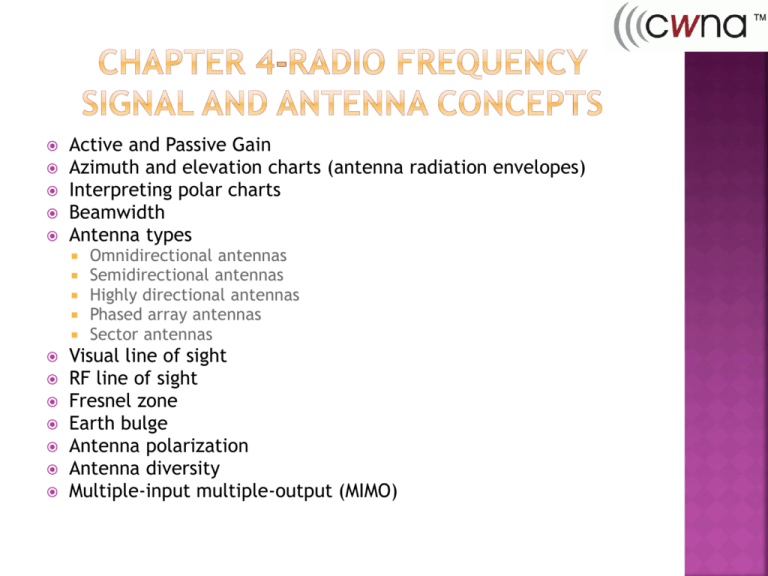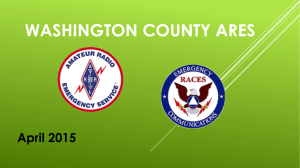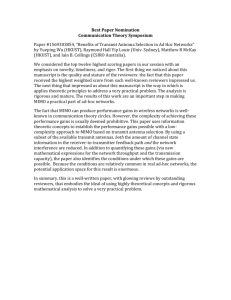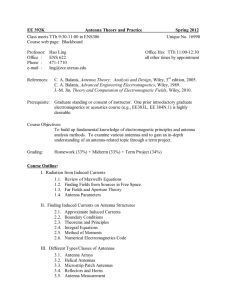Semi-directional Antennas
advertisement

Active and Passive Gain Azimuth and elevation charts (antenna radiation envelopes) Interpreting polar charts Beamwidth Antenna types Omnidirectional antennas Semidirectional antennas Highly directional antennas Phased array antennas Sector antennas Visual line of sight RF line of sight Fresnel zone Earth bulge Antenna polarization Antenna diversity Multiple-input multiple-output (MIMO) Understand passive and active gain Understand how antennas provide passive gain and how transceivers and amplifiers provide active gain. Know the different categories and types of antennas, how they radiate signals, and what type of environment they are used in. Make sure you know the three main categories of antennas and the different types of antennas. know the similarities and differences between them, and understand when and why you would use one antenna over another. Make sure that you understand azimuth and elevation charts, beamwidth, antenna polarization, and antenna diversity. Fully understand the Fresnel zone. Make sure you understand all of the issues and variables involved with installing point-to-point communications. You are not required to memorize the Fresnel zone or earth bulge formulas; however, you will need to know the principles regarding these topics and when and why you would use the formulas. Understand the concerns associated with connecting and installing antennas and the antenna accessories. Every cable, connector, and device between the transceiver and the antenna affects the signal that gets radiated from the antenna. Understand which devices provide gain and which devices provide loss. Understand what vSWR is and what values are good or bad. know the different antenna accessories, what they do, and why and when you would use them. Signal must be radiate with enough power so that is will be understood by the receiver Antenna installation will have a great effect. Simple-omni-directional in middle of office Complex-multiple semi-directional antennas Pg 107 Measurements of the increase in signal from the Antenna (EIRP) If gain is from an amplifier or increased power at the transmitter-it is ACTIVE Gain If from shaping or focusing the power with an antenna,-PASSIVE Gain Passive gain from focusing existing Power Active Gain by adding more power Pg 107 Focusing isotropic energy in a specific pattern Created by the design of the antenna Uses the magnify glass concept Providing an external power source Amplifier High gain transmitters Charts help you “see” how antennas focus energy Polar charts or antenna radiation envelopes Pg 109 In either chart, the antenna is placed at the middle of the chart. Azimuth chart = H-plane = top-down view Elevation chart = E-plane = side view Like casting a shadow with your hand Shape is same, but size grows with power. Pg 109 Easy to misinterpret The chart shows the DECIBEL mapping of coverage Each line 5 dB!! Normalized charts appear very different Pg 110 Easy to misinterpret The chart shows the DECIBEL mapping of coverage Each line 5 dB!! Normalized charts appear very different Pg 110 The measure of how broad or narrow the focus of an antenna is Measured both horizontally and vertically To the point where the signal decreases by half power (-3dB) Pg 113 First determine the scale of the polar chart. On this chart, you can see that the solid circles represent the –10, –20, and –30 dB lines, and the dotted circles therefore represent the –5, –15, and –25 dB line Now to determine the beamwidth of this antenna, frst locate the point on the chart where the antenna signal is the strongest. In this example, the signal is strongest where the number 1 arrow is pointing. Move along the antenna pattern away from the peak signal (as shown by the two number 2 arrows) until you reach the point where the antenna pattern is 3 dB closer to the center of the diagram (as shown by the two number 3 arrows). This is why you needed to know the scale of the chart first. Draw a line from each of these points to the middle of the polar chart (as shown by the dark dotted lines) and measure the distance in degrees between these lines to calculate the beamwidth of the antenna. In this example, the beamwidth of this antenna is about 30 degrees. Pg 113 Omnidirectional Semidirectional Omnidirectional antennas radiate RF in a fashion similar to the way a table or foor lamp radiates light. They are designed to provide general coverage in all directions. Semidirectional antennas radiate RF in a fashion similar to the way a wall sconce radiates light away from the wall or the way a street lamp shines light down on a street or a parking lot, providing a directional light across a large area. Highly directional Highly directional antennas radiate RF in a fashion similar to the way a spotlight focuses light on a fag or a sign. Pg 115 Antennas not only amplify transmitted signal, they amplify received signal Pg 115 Common on many access Points Dipole Rubber duck Bagel shaped transmission Wide horizontal coverage Limited vertical coverage Low gain antennas are usually 2.14dB Higher gain is more elongated Pg 116 Low Gain Omni-directional Antenna The omni antenna is the most commonly used antenna type Provides 360º horizontal coverage pattern along a flat plane. Gain of signal along the horizontal plane means less signal along the vertical plane Omni-directional antennas are also known as dipoles. High Gain Omni-directional Antenna Antennas are most effective when the element is an even fraction or a multiple of the wavelength (λ) ¼, ½, 1, 2, etc. Higher gain antennas are often made by stacking dipole antennas Used in multipoint environments Indoor Access Point Building to multiple building coverage Beware of higher gain limiting the vertical coverage Pg 117 Designed to direct the signal in a specific direction Point to point-outdoors about a mile Down hallways Three Planar Type types Patch Panel Yagi Pg 118 Multiple planar antennas can be used to cover multiple aisles Libraries, Warehouses, Retail, etc Yagi antennas are like old TV antennas However, each element is fitted for wireless wavelengths Even fraction or multiple of wavelength Pg 119 Also good on walls Most have limited side lobe and vertical and can be pointed down for coverage Pg 121 Patch Semi-directional Antennas Patch Patch, Panel, Yagi and Sector are the primary semidirectional antenna types on the market today Semi-directional antennas have 180º or less of horizontal and vertical beam width Primary coverage uses include: Hallways/Corridors Wireless ISPs PTP & PTMP Bridging Multiple semi-directional antennas can be combined into an array to provide omni-directional coverage. For Point to Point Generally between two buildings Focused, narrow beamwidth Two main types Parabolic Dish Grid Antenna Since they are used outdoors, wind loading is an issue Since they have narrow beamwidth, the wind can push them out of direction Pg 121 Highly focused energy Most common type - parabolic Multiple antennas connected to a signal processor Different antennas can be fed different phases Able to create very directed beams Usually regulated differently Not common in 802.11 802.11n has a PHY specification that supports it Smart antenna technology Pg 123 Specialized high gain, semidirectional antenna Multiple antennas with limited back lobe Each antenna can be on its on its own transceiver Usually set up to provide 360 degree coverage Used extensively in cellular phone systems Pg 123 The Visual LOS is not important on Wireless networks RF “line” from source to destination line of sight is Mostly for outdoor point to point connections Should be unobstructed Pg 124 Visual line of sight RF line of sight Fresnel zone Football shaped area around the “LOS” Actually multiple zones surrounding the main line of sight If first Fresnel zone is obstructed, it will affect the transmissions more than 40% will make link unrealiable Keep it to less than 20% Pg 125 You need to understand how the calculations will affect placement when designing a point to point. Can calculate the size of the zone in middle Or at certain distances Important for keeping out obstructions Pg 125 Don’t mistake smaller beamwidth for smaller Fresnel zone Fresnel zone is affected by the frequency of the transmission, not the antenna Pg 128 For longer Point to Point links-More than 7 miles Important to calculate height requirements for towers Pg 128 Alignment of the antenna can affect polarization Doesn’t matter if it is horizontal or vertical, both transmitter and receiver need to be the same way Most systems have antenna diversity Multiple antennas (more than one wavelength away) If the Received Signal Level (RSL) is 10 to 15 dB less than expected, you may be linking to a side lobe Pg 130 Helps compensate for multipath An AP has multiple antennas Compares the signal from each antenna and choose the best signal 802.11n uses switched diversity Signal with the best amplitude is used Also known as received diversity Can also use measurement to choose the transmit antenna Pg 130 Don’t put the antennas in different locations or point in different directions That defeats the purpose Usually a single radio with multiple connections Common inside laptops Pg 130 More sophisticated type of antenna diversity Takes advantage of multipath Uses Space Time Coding Send multiple signals simultaneously Pg 132 Measure of the change in impedances to an AC signal When there is a difference or mismatch in impedance between devices in a RF system Forward Energy is reflected backward to the transmitter Usually at points where you are connecting Cable to transmitter Cable to antenna Pg 133 Ratio of energy reflected is the voltage reflection coefficient Return Loss Ideally, there is no mismatch A matched cable, 0 ratio, infinite return loss VSWR is a measure between the maximum voltage and minimum voltage VSWR=Vmax/Vmin Pg 133 Higher the return loss, the less broadcast power Return voltage can also damage the transmitter Pg 133 The goal when connecting the antenna to transmitter is to reduce signal loss Must pay attention to devices used Cables and connectors Pg 134 Placement Mounting Appropriate Use Orientation and alignment Safety Maintenance Pg 134 Correct placement for type of antenna Omnidirectional toward center Semi-direction at edge, pointed toward center Pay attention to vertical and horizontal coverage Also, power levels Too high a power will provide an overlarge coverage area Security risk Outdoors-Watch the Fresnel Zone Pg 135 Outdoors Masts or towers Indoors Wall or ceiling Often want to hide or camouflage for aesthetics Pg 135 Indoor vs. Outdoor Although they look the same, they are designed for correct temperature and environment Pg 136 Pay attention to horizontal vs. vertical alignment Polarization can make the difference between being able to communicate or not Pg 136 Be careful RF health and safety courses FCC and OSHA regulations If installing on a tower, pole, etc-get a professional. Pg 135 Preventative and diagnostic Don’t just set and forget Especially not outdoors Outdoors you need to be aware of wind and water damage Wind Properly mount Water Cold-shrink tubing, sealant, drip loops Pg 137 All devices attached in the RF system need to be checked for Frequency response Impedance VSWR Maximum input power Insertion loss Pg 137 Choose the correct cable based on technology, frequency, etc Some cables can’t be used with some frequencies Match the impedance Calculate the signal loss Different for different frequencies Purchase pre-cut of hire a professional You want to measure loss in the connections Pg 139 FCC has mandated that manufacturers use unique connectors to limit the ability to use noncertified antennas Pigtail adapters get around this requirement Be careful of exceeding FCC regulations Pg 139 Join cables and devices together AP to antenna Antenna to cable Cable to cable Etc. Signal splitter, RF splitter, Power Splitter Used when you need the signal to go to more than one location Multiple antennas Will cause loss and degradation of signal Power monitoring Pg 139 For active gain Unidirectional transmit only Bi-directional Transmit and receive Fixed Generate a signal equal to that of the amplifier Fixed output Gain Adds amplifier to transmitter power Pg 140 In cases where you need to limit the range or power If the minimum power setting isn’t small enough Pg 140 Protect from power surges due to nearby strikes Direct strike will fry it Protects the devices behind it on the circuit Pg 141 Lightning Arrestors Does not prevent equipment loss in cases of direct lightning strikes! An in-line RF device that must be connected to Earth ground Dissipates static electricity in the air When objects near RF antennas are struck, electrical current is induced Pg 141 Important to have a common ground Properly sunk copper rod and connectors Tinned copper wire to connect tower legs Pg 142 Understand passive and active gain Understand how antennas provide passive gain and how transceivers and amplifiers provide active gain. Know the different categories and types of antennas, how they radiate signals, and what type of environment they are used in. Make sure you know the three main categories of antennas and the different types of antennas. know the similarities and differences between them, and understand when and why you would use one antenna over another. Make sure that you understand azimuth and elevation charts, beamwidth, antenna polarization, and antenna diversity. Fully understand the Fresnel zone. Make sure you understand all of the issues and variables involved with installing point-to-point communications. You are not required to memorize the Fresnel zone or earth bulge formulas; however, you will need to know the principles regarding these topics and when and why you would use the formulas. Understand the concerns associated with connecting and installing antennas and the antenna accessories. Every cable, connector, and device between the transceiver and the antenna affects the signal that gets radiated from the antenna. Understand which devices provide gain and which devices provide loss. Understand what vSWR is and what values are good or bad. know the different antenna accessories, what they do, and why and when you would use them.
![EEE 443 Antennas for Wireless Communications (3) [S]](http://s3.studylib.net/store/data/008888255_1-6e942a081653d05c33fa53deefb4441a-300x300.png)


